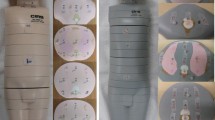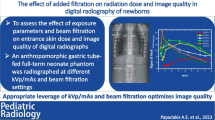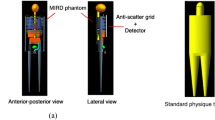Abstract
Background
The acquisition of chest radiographs in neonates is of critical importance in diagnostics because of the risk of respiratory distress syndrome and pneumothorax in preterm infants.
Objective
To achieve a dose reduction while preserving a diagnostic image quality for chest radiographs of neonates.
Materials and methods
All radiographs, generated on a fully digital X-ray unit by using a neonatal chest phantom, were evaluated under variation of the tube voltage (40–70 kV) and mAs levels (1–10.2 mAs) with and without an additional 0.1-mm copper (Cu) filtration. Noise, contrast and contrast-to-noise ratio for bronchus, heart, lungs and vessels were determined. Visual assessment of the image quality was carried out by three radiologists using a Likert scale. To evaluate a maximally possible dose reduction, the dose of the radiographs with still acceptable image quality at a minimal dose was compared to the dose of the radiographs with the standard settings used in clinical routine.
Results
The noise showed decreasing values with increasing dose, while the contrast values were increased. For the contrast-to-noise ratio, a digressive course of the values as a function of the tube voltage was found. The visual evaluation of image quality showed the best evaluation of the structures at the lowest possible dose in the settings (44 kV, 3.36 mAs) with copper filtration and in the settings (44 kV, 1.56 mAs) without copper filtration. A maximum dose reduction from 8.29 μSv to 2.21 μSv (about 73%) was obtained.
Conclusion
A dose reduction while preserving diagnostic image quality in a digital X-ray system is generally possible by reducing the tube voltage and simultaneous adaptation of the mAs settings.






Similar content being viewed by others
References
Speer CP (1999) lung diseases of the neonatal. in Harnack GA, Koletzko B (ed) Kinderheilkunde (Pediatrics). 11th edn. Springer Verlag, Berlin, pp 78-86
Hahn G, Glutig K (2009) medical imaging. in: Pädiatrie. 3rd edn. Springer, Berlin, Heidelberg, pp 1025-1041
Bundesärztekammer (2008) guidelines of the Federal Medical Association for quality assurance in radiodiagnostics. http://www.bundesaerztekammer.de/downloads/LeitRoentgen2008Korr2
Hall EJ (2002) Lessons we have learned from our children: cancer risks from diagnostic radiology. Pediatr Radiol 32:700–706
Spahn M, Heer V, Freytag R (2003) Flat-panel detectors in X-ray systems. Radiologe 43:340–350
Hamers S, Freyschmidt J, Neitzel U (2001) Digital radiography with large-scale electronic flat-panel detector vs screen-film radiography: observer preference in clinical skeletal diagnostics. Eur Radiol 11:1753–1759
Busch HP (1999) Digial projection radiography. Technical bases. Imaging quality and usefulness. Radiologe 39:710–724
Gammex Inc (2008) Physics behind the phantom, volume 2: the neonatal chest. A white paper report. http://cspmedical.com/content/102-1922_neonatal_phantom_white_paper.pdf
Becht S, Bittner R, Ohmstede A et al (2008) Zimmer-Brossy M (ed) Textbook of the X-ray diagnostic adjustment technique, 6th edn. Springer-Verlag, Berlin
Bach M, Wesemann W, Kolling et al (2008) Photopic contrst sensitivity. Local contrast perception. Ophthalmologe 105:46–59
DIN Deutsches Institut für Normung e.V (1997) terminology of physiological optics. (DIN 5340). Beuth, Berlin
Hess R, Neitzel U (2012) Optimizing image qualitiy and dose for digital radiography of distal pediatric extremeities using the contrast-to-noise ratio. Rofo 184:643–649
Mohrs OK, Pettersen SE, Schulze T (2010) High-resolution 3D unenhanced ECG-gated respiratory-navigated MR angiography of the renal arteries: comparison with contrast-enhanced MR angiography. AJR Am J Roentgenol 195:1423–1428
Körner M, Wirth S, Treitl M et al (2005) Initial clinical results with a new needle screen storage phosphor system in chest radiograms. Rofo 177:1491–1496
Bulla S, Pache G, Blanke P et al (2011) Reduction of radiation dose in low-dose CT of the paranasal sinuses using iterative image reconstruction: feasibility and image quality. Rofo 183:VO409_1
Gosch G, Gosch K, Kahn T (2007) Conversion coefficients for estimation of effective dose to patients from dose area product during fluoroscopy x-ray examinations. Rofo 179:1035–1042
Gislason AJ, Davies AG, Cowen AR (2010) Dose optimization in pediatric cardiac x-ray imaging. Med Phys 37:5258–5269
Hansson B, Finnbogason T, Schuwert P, Persliden J (1997) Added copper filtration in digital paediatric double-contrast colon examinations: effects on radiation dose and image quality. Eur Radiol:1117–1122
Redlich U, Hoeschen C, Doehring W (2005) Assessment and optimisation of the image quality of chest-radiography systems. Radiat Prot Dosimetry 114:264–268
Smet MH, Breysem L, Mussen E et al (2018) Visual grading analysis of digital neonatal chest phantom X-ray images: impact of detector type, dose and image processing on image quality. Eur Radiol 28:2951–2959
Rattan AS, Cohen MD (2013) Removal of comfort pads underneath babies. a method of reducing Radiation exposure to neonates Acad Radiol 20:1297–1300
Stenzel M, Mentzel HJ (2011) Digitale Thorax-Radiographie in der Neonatologie - Dose optimization using a neonatal phantom. Monatsschr Kinderheilkd 159(Suppl 3):230–240
Smans K, Struelens L, Smet M et al (2010) Cu filtration for dose reduction in neonatal chest imaging. Radiat Prot Dosim 139:281–286
Launders JH, Cowen AR, Bury RF, Hawkridge P (2001) Towards image quality, beam energy and effective dose optimisation in digital thoracic radiography. Eur Radiol 11:870–875
Wiltz HJ, Petersen U, Axelsson B (2005) Reduction of absorbed dose in storage phosphor urography by significant lowering of tube voltage and adjustment of image display parameters. Acta Radiol 46:391–395
Steidle G (2004) Two-dimensional parallel acquisition technique in 3D MR colonography. Fortschr Röntgenstr 176(08)
Rühm SG, Debatin JF (1999) Contrast-enhanced 3D MR-angiography of the thorax, abdomen and lower extremities. Radiologe 39:100–109
Schaefer-Prokop CM, Prokop M (1996) Digital radiography of the thorax - the selenium detector compared to other imaging systems. Kontraste 09: 14-23
Schaefer-Prokop CM (1997) Digital Radiography of the Thorax - A system comparison, taking into account dose requirements and diagnostic performance in comparison to conventional film-screen radiography [Habilschr med.]. Hannover: Medical College
Dougeni ED, Delis HB, Karatza AA et al (2007) Dose and image quality optimization in neonatal radiography. Br J Radiol 80:807–815
Author information
Authors and Affiliations
Corresponding author
Ethics declarations
Conflicts of interest
None
Additional information
Publisher’s note
Springer Nature remains neutral with regard to jurisdictional claims in published maps and institutional affiliations.
Rights and permissions
About this article
Cite this article
Schäfer, S.B., Papst, S., Fiebich, M. et al. Modification of chest radiography exposure parameters using a neonatal chest phantom. Pediatr Radiol 50, 28–37 (2020). https://doi.org/10.1007/s00247-019-04522-1
Received:
Revised:
Accepted:
Published:
Issue Date:
DOI: https://doi.org/10.1007/s00247-019-04522-1




